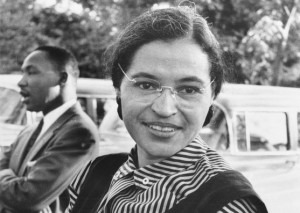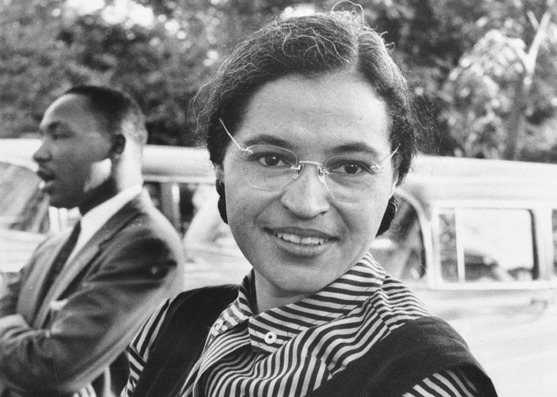
On Dec. 1, 1955, on her way home from her job as an assistant tailor at a Montgomery, Ala., department store, Rosa Parks refused when prompted to give up her public bus seat to a white passenger. As an African-American, her act of civil disobedience challenged one of the segregation customs that governed daily life in the South, and as a result, James Blake, the bus’s white driver, threatened to have her arrested.
In her autobiography, My Story, Parks remembered saying to Blake, “You may do that.” When two white policemen arrived she asked them, “Why do you all push us around?” One of them answered, “I don’t know, but the law is the law…” Her subsequent arrest sparked a bus boycott by the African-American community in Montgomery, led to the U.S. Supreme Court’s 1956 ruling that segregation on public buses was unconstitutional and brought a new-to-town-preacher named Martin Luther King, Jr., to national prominence.
Mention the name “Rosa Parks” and most Americans will call to mind some or all of the preceding details of her story. But there are other intriguing details shared in her autobiography, from both before and after her fateful choice in December 1955, that are perhaps not as well-known.
At age 20, Parks graduated from high school, something few blacks of that time and region were able to do. In the winter of 1943, the same bus driver who infamously had her arrested in 1955, put her off his bus for refusing to get off the bus and back on after initially boarding, a common requirement of some drivers for their African-American passengers. Between 1943 and 1945, despite the inequalities of the voting process in Alabama, including a retroactive poll tax, Parks tried three times to register to vote. She succeeded on her third try.
Parks also joined the National Association for the Advancement of Colored People (NAACP), a civil rights organization with a branch in Montgomery, and was one of only three women (and a few local whites) who became members. She was the group’s secretary at the time of her arrest.
During the summer of 1955, Parks received a scholarship that enabled her to spend 10 days at the Highlander Folk School in Monteagle, Tenn., discussing racial desegregation and ways to implement the landmark 1954 U.S. Supreme Court case Brown v. Board of Education.
In the meantime Edgar Nixon, the head of the NAACP in Montgomery, had been looking for a “test case” and a client—preferably a woman in order to elicit more sympathy—who could challenge local bus segregation. At least two other women besides Parks were arrested in 1955 for refusing to give up their seats on a Montgomery city bus; however, one was pregnant and unmarried, making her a ripe target for character assassination, and the other paid her fine and withdrew quietly. Despite knowing that the NAACP needed an upstanding plaintiff, Parks insisted, “That is not why I refused to give up my seat to a white man…I did not intend to get arrested.” In fact, having regularly avoided boarding buses driven by Blake since their run-in in 1943, she wrote that she never would have gotten on the bus had she noticed he was the driver.

However, Parks did board that fateful Cleveland Avenue bus on Thursday, Dec. 1, 1955, and sat in the front of the “colored” section located in the middle of the bus. At first, she sat next to two other African-American women and an African-American man. At the next stop, several white passengers boarded, leaving one white man standing. That’s when Blake demanded of Parks and her three row-mates, “Let me have those front seats.” By common practice African-Americans sitting in those seats were required to stand in the back of the bus if all the seats designated for whites were otherwise full. The other three complied. Parks did not. “People always say that I didn’t give up my seat because I was tired, but that isn’t true,” she wrote. “I was not tired physically, or no more tired than I usually was at the end of a working day. I was not old, although some people have an image of me as being old then. I was 42. No, the only tired I was, was tired of giving in.”
The evening of her arrest, Parks was fingerprinted and photographed before she was able to call her husband to come bail her out, but word of what had happened to her had already spread. Nixon arrived at the jail with white civil rights attorney Clifford Durr, and Durr’s wife, Virginia, and paid her bail. Her court date was set for Monday, Dec. 5. She remained outwardly calm throughout her ordeal, despite not knowing if a beating, or worse treatment, awaited her, but wrote that she didn’t realize how much it had affected her until she was leaving the jail.
Nixon, who held a job as a Pullman train porter, soon asked Parks to be a “test case.” She remembered him saying, “My God, look what segregation has put in my hands.” After consulting with her mother and her husband, Raymond, Rosa agreed. Her arrest sparked a bus boycott organized and sustained for a full year by Montgomery’s African-American community. In December 1956, the boycott ended after the successful integration of city buses, having served as a key training ground for civil rights leaders like King, Ralph Abernathy and others.
For her part, Parks lost her department store job. Raymond Parks resigned from his job at a barber shop at nearby Maxwell Air Force Base because the owner banned discussion of his wife’s case and the bus boycott in his shop. Raymond started sleeping with a gun nearby after the Parks family started receiving threatening phone calls. While Rosa Parks became a well-known activist for civil rights, she, Raymond and her mother found it necessary to move away from Montgomery. The three eventually settled in Detroit, Mich.
Rosa Parks was one of the few women recognized during the March on Washington for civil rights in 1963. She wrote, “Nowadays women wouldn’t stand for being kept so much in the background, but back then women’s rights hadn’t become a popular cause yet.” Parks spoke actively into the 1980s, and received the distinction of being named “the first lady of civil rights” by the U.S. Congress.
“If we can keep Rosa Parks in a museum as an untouchable icon of truth, we will remain untouchable as well: we can put her up on a pedestal and praise her, world without end, never finding ourselves challenged by her life.” (Parker Palmer, Let Your Life Speak)


